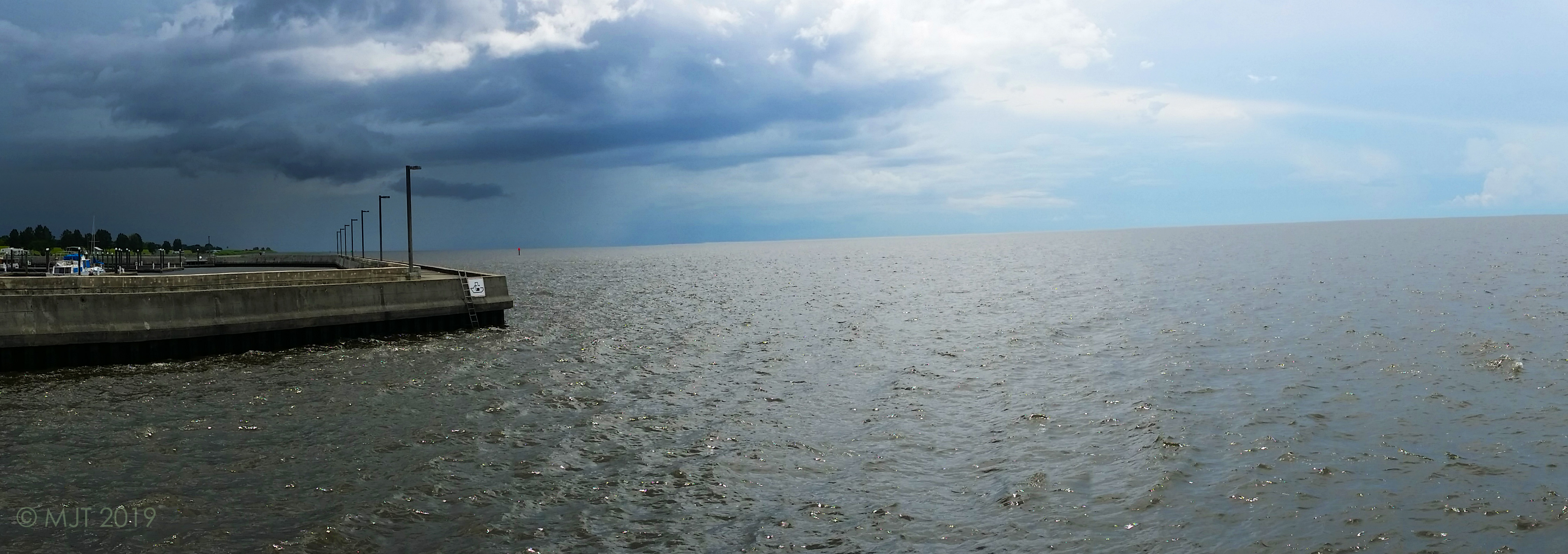MIAMI – The issues around water resources in South Florida are complicated and entirely human caused. They uniquely center around trying to contain Lake Okeechobee, often called Florida’s Inland Sea. Lake Okeechobee is the second largest natural freshwater lake in the contiguous US and roughly half the size of the US State of Rhode Island. The Hitchiti Native people named the lake, big (oki), water (chubi).
Lake Okeechobee is shallow averaging around 9ft (2.8 m) in depth. It is the main water reservoir for the tropical wetlands of south Florida commonly called the Everglades, a region that encompasses not only Everglades National Park but a series of state and federal preserves that form the largest wilderness area east of the Mississippi river.

Lake Okeechobee from Pahokee [Credit: M Tejeda-Moreno]
That strategy set in motion a near century-long effort to subordinate the unpredictable overflow from Lake Okeechobee into the surrounding regions. Of course, Everglades evolved under these conditions so it experiences no adversity. But the human presence, specifically, the desire to subordinate water flow in the Everglades Agricultural Area led to massive federal projects especially after 2,500 individuals drowned after the 1928 hurricane released a southbound storm surge from the lake.
The water management of the region has created interpersonal, political, and economic tensions in South Florida. Most seriously, the attempts to control the water have resulted in vast environmental damage. The damage has resulted in the dangerous algal blooms that have occurred in Florida over the past couple of years; but it also goes beyond the immediately visible waters into the land. The damage goes deep into the earth with consequences that range from arsenic mud to extensive wildfires to saltwater intrusion in the local aquifer that serves as the drinking source for the 7 million people living the Miami-Fort Lauderdale-West Palm Beach Metropolitan area. The many moving pieces of the South Florida water “problem” are devilishly complicated.

Betty Osceola and Holley Rauen at John Stretch Park. [Photo Credit: Lisette Morales] [Courtesy]
Betty is a member of the Panther Clan of the Miccosukee Tribe of Indians of Florida. She avoids the term leader and is clear that she has no formal role in the community, “I’m not an elder or leader or anything”. She prefers to say, “I’m just an indigenous grandmother”. And she is a powerful voice for the water.
Betty’s connection to the land is part of her ancestry and she used to walk the area around the Lake with her uncle. She’s learned to listen: to the water and to the people who live near it.
In our conversation, she shares that a year ago, “I was driving by the Lake and I got this feeling from the Lake. I knew I needed to come and pray for the Lake. I thought about it and, then it became clear, I know the Lake needed prayer.”
So last year, she organized a prayer vigil for the Lake. And in that prayer, she sensed more was needed, there was much damage and more spiritual energy and attention had to be directed at the waters of the Lake. “We really got the feeling that we need to walk around the lake. Pray for the Lake, around the lake.”
Betty is making that happen. This weekend, she and a group of about 40 others will walk the 110-mile circumference of Lake Okeechobee. Over the seven-day trek they will be stopping at cardinal points and praying for healing.

Holley Rauen at John Stretch Park. [Photo Credit: Lisette Morales] [Courtesy]
While Betty has been handling on the ground logistics related to the walk, Holley has been organizing the support needed for the prayer walkers. They’ve organized other events, but this is the most expansive and perhaps the most complicated.
Holley and Betty invite everyone who cannot attend physically to join energetically in the Honoring the Sacred Water public group on Facebook. It is on that site where they will be sharing information about the events that occur during the walk and where they will be live-streaming the daily devotional, prayer and blessing.
Holley is coordinating the energetic movement and prayer every morning. She invites everyone to share and raise energy and prayer for the work being done by the walkers. She will also be doing a Facebook live-stream at about sunrise Eastern time with the event led each of the seven days by a member of an indigenous community from around the world, for example, on Monday Great Grandmother Mary Lyons of the Ojibwe Tribe of Minnesota will lead the prayer and water blessing at sunrise. The seven days of coordinated global prayer will help begin to heal the relationship with water.
Holley added that they also need hospitality support; so anyone interested in offering should visit their event page on Facebook. The walkers will begin on January 26, 2018 and continue for seven days walking about 18 miles each day and stopping at designated camp sites. They can use some supplies, but community members are also working on organizing some hot meals to support them.

Near Lake Okeechobee [Photo Credit: JB Carlos] [Courtesy]
Betty added that, “The water is not our enemy, but we keep trying to treat her as if she is the one injuring us. In reality, we are abusing her. We are enslaving her to what we want. We need to heal our relationship with the water.” And to begin that, she says, we need to “ask the water to forgive us”.
The Wild Hunt is not responsible for links to external content.
To join a conversation on this post:
Visit our The Wild Hunt subreddit! Point your favorite browser to https://www.reddit.com/r/The_Wild_Hunt_News/, then click “JOIN”. Make sure to click the bell, too, to be notified of new articles posted to our subreddit.
